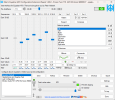Even such cheap speaker don't need to sound that bad. They simply had no one who knew anything about speaker construction. From the pictures we can see they only did cheap optical copys of much better speakers and some awkwardly driver combinations only completely clueless people could make.
What a waste of material.
There are quite some free, private developer, who do super cheap constructions for a hobby, sometimes even as a kind of contest. You can build a decend 2-way speaker from less than 20€ surplus material with a very surprising sound quality. Downside, these surplus drivers and parts are usually not available for long.
Of course, these guy's know a lot about construction, theory and have years of experience. They do expensive things, that are free to copy, as well.
Most good speaker builder started with cheap material and tried to make them sound better than the price allowed. It may be even more rewarding than sticking some expensive high end stuff in a box and make a mediocre speaker from it. Something I see too often.
So shame on these Swedish, hopefully long gone, brands. Sometimes I see compareable speaker in discount stores, WATSON and ELTA come to my mind. MAGNAT sometimes does such felt covered, piezo horn and huge woofer equipped curiosities too, offered in grocery stores between cornflakes and toilet paper. There should be a law to prohibit this useless waste of resources. Some people in the industry are only satisfied when the colorful packaging was been more expensive than the product inside. What a wonderful world we live in...
:

